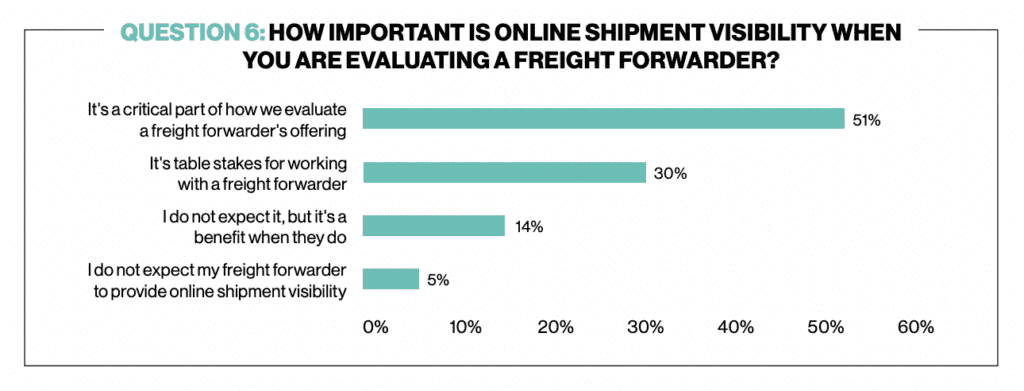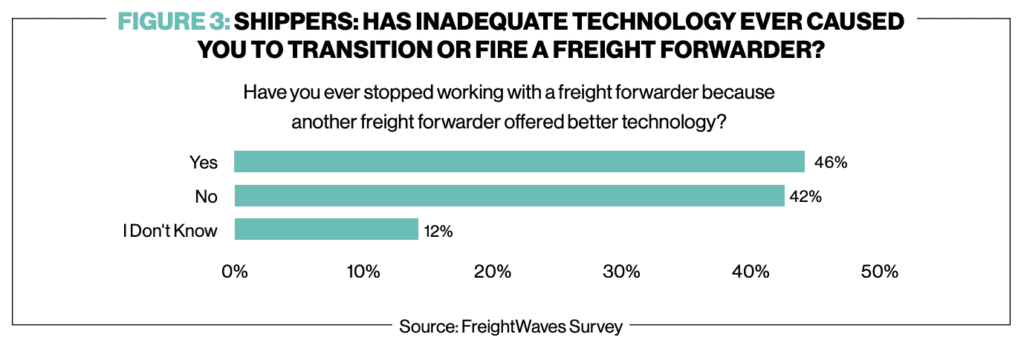In this article
COVID-19 sent shockwaves through markets across the world, including the logistics industry. In the midst of a rapidly shifting landscape, freight forwarders are left scrambling. On top of their day-to-day responsibilities, many are also dealing with novel issues resulting from shut-downs and economic uncertainty.
Unfortunately, with freight forwarding’s critical role in the supply chain, there’s no time to waste. Tackling your problems head-on is key to managing costs and increasing revenue in this increasingly competitive business.
1. Container shortages
If you’ve been in the industry for a while, you may have noticed heightened difficulty in securing shipping space since the start of the pandemic. There are several reasons for this phenomenon, starting with a decrease in shipping vessels in 2020 in response to lowered demand.
Port congestion has compounded on that problem, as evidenced by increased dwell and transit times. In other words, since containers are taking longer to make a single delivery, they can’t maintain the same velocity as before. This, coupled with strong consumer demand, makes for an extremely limited supply of shipping capacity.
The solution:
In the short term, there are a couple of strategies you can employ to secure space despite the shortage. For one, less than container load (LCL) shipping can be a cost-effective option when your cargo is unable to fill a whole container. Premium spaces are also available for shipments on a tight timeline, but they’re often too costly for most freight forwarders.
As a more sustainable solution, lean into the predictive side of your shipping process. Start collecting as much order and shipment information as possible. From there, you can leverage a digital tool to continuously analyze the data and optimize your predictions. Once your forecast accuracy improves, you’ll be able to more reliably secure the space you need ahead of time.
2. Rising consumer expectations
While many businesses struggled to adjust to the post-pandemic landscape, consumer expectations rose as shoppers increasingly relied on online retail for luxuries and necessities alike.
Thanks to tech-forward e-commerce giants like Amazon, they’ve also grown accustomed to fast, low-cost shipping and granular status updates.
NEOLink director Sean Crook speculated on these heightened expectations in a recent webinar The ROI of Digitization in Freight Forwarding.
“The customer expectation level has risen because their customer’s expectation level has risen,” Crook said. “If you look at Uber and all of these different apps, I think a lot of them have trained people into thinking, ‘I can get my information in real-time, easy– I can see where it is, I can see where it’s on the way.’”
This trend, known as the Amazon Effect, has increased pressure on shippers and, in turn, freight forwarders. However, with much smaller budgets and thinner profit margins, many freight forwarding companies would need to incur significant costs to keep up with the standards that their competitors have set.
Still, providing visibility is becoming an expectation for many shippers as they strive to meet consumer demands. In fact, 81% of shippers report that shipment visibility is either table stakes or a critical part of how they evaluate potential freight forwarders.

The solution:
Implement a system to give your shippers access to real-time data. By providing them with a centralized hub, you can keep them from relying on emails and calls. Not only will they feel more informed about their shipment status, but your team will also save time they would’ve spent providing unnecessary updates.
3. Changing laws and regulations
As a central player in the economy, the logistics industry tends to be a popular topic of discussion for politicians and lawmakers. Policy changes can provoke immediate adjustments and responses from affected parties, sending ripple effects across the industry.
Oftentimes, these issues will compound, as we’ve seen with the intersection of events like the China-US trade war, the Clean Shipping Act, and reactions to AB5.
Jonathan Gold, VP of Supply Chain and Customs Policy at the National Retail Federation, commented on the ongoing uncertainty in the industry following AB5 protests in a recent webinar. “This is one additional supply chain disruption that we do not need at this point in time,” Gold said. “Now you’re looking at every segment of the transportation chain now being impacted by something, whether it’s potential strike, disruption, or folks just not having a job.”
Whether or not you’re directly affected by every change, you’re still likely to see the effects somewhere down the line. Staying up-to-date on industry news can be key in enabling your company to make proactive decisions and keep up with competitors.
The solution:
Pay close attention to political news stories, and make sure that any regulatory changes are incorporated into your standard processes and training materials. Additionally, make a habit of reading up on logistics news, and encourage your team to do the same. Keep note of a few sources to consistently follow, including industry-relevant newsletters, webinars, and conferences.
4. Increasing competition
Many freight forwarders are accustomed to battling constant threats of competition, largely due to the industry’s low barriers to entry. On top of that, shippers typically see freight forwarding as a commodity, prioritizing speed and pricing over brand loyalty.
Shippers are also increasingly prioritizing customer experience and digital solutions in finding a partner. In fact, in a survey we conducted with FreightWaves, 46% of shippers reported that they’d stopped working with one freight forwarder because another offered better technology.
Therefore, many traditional freight forwarding companies are struggling to compete against new entrants, especially with the influx of digital-first agents like Flexport.

The solution:
Overcome the trap of commoditization by differentiating your business. Many digital-first freight forwarding companies have a good handle on the tech and operations side. However, they haven’t always developed the same connections and industry knowledge as their traditional freight forwarding competitors.
Reputation and relationships alone are no longer enough to secure business in this industry. However, by combining that with digital advantages like real-time tracking and data analysis, you can position your business to stand out from competitors on both sides.
5. Labor shortages
Even as pandemic recovery seems to be on the horizon, industries across the globe are continuing to face labor shortages, and freight forwarding is no exception. Between health concerns, closed borders, and competition from other industries, many freight forwarders are struggling to find the talent they need.
The U.S. Bureau of Labor Statistics reported an annual separations rate of 54.5% in the Trade, Transportation, & Utilities industry in 2021, down from 60.4% the year before.
Holly Scott, a director at OrangeLime Consulting, has noticed a shift in the industry as employees are pushing for flexible and remote work. “It’s shrinking, it’s changing, it’s demanding more– it’s demanding to be able to work remotely,” Scott said.
For this reason, forwarding companies who rely on manual, in-person processes can be disproportionately affected by these scarcities.
The solution:
Automate manual tasks where possible to shift some of the burden off of your employees. By cutting out repetitive work, you can reduce the need to recruit more employees every time you gain a new customer.
Digitizing processes can also allow employees more flexibility, leading to a happier workforce. “If everyone can connect, get more done with technology and fewer people, no matter where they are, then everyone gains,” Scott said.
6. Volatile shipping prices
Shipping prices have long been a hot topic in the industry, especially since their astronomical peak in the fall of 2021. Freight rates can be hard to predict due to the sheer volume of factors, from fuel prices and seasonal surcharges to labor costs and political crises.
Dealing with price uncertainty is an inevitable by-product of working in logistics. However, as a freight forwarder, it can be especially frustrating to be faced with countless questions from shippers every time the rate fluctuates.
The solution:
When combatting temporary price hikes, make an effort to negotiate better rates with carriers. Aside from leveraging connections, you can also try booking outside of peak season or negotiating contracts with fewer PSS adjustments.
However, when faced with long-term rate volatility, you’ll also want to establish open communication with your shipper. “The only way to properly support your customer base in this type of environment is transparency and honesty,” said David Bennett, Chief Commercial Officer at Farrow. “Do not try to mislead or overpromise and under-deliver.”
7. Unexpected delays
If you’re like most freight forwarders, you’re probably way too familiar with the question, “Where’s my shipment?” Unfortunately, delays can occur for any number of reasons, including weather conditions, unexpected detours, or last-minute route changes.
While the cause of a late shipment is typically out of your control, you’re still responsible for communicating an updated timeline to frustrated shippers.
The solution:
Implement the technology you need to gain enhanced visibility into your shipments. Pay attention to cargo in transit, and if you notice any extended delays, make an effort to unblock them.
Over time, review data to figure out where your delays are coming from, and adjust your operations accordingly. You may even be able to use this information to more accurately evaluate carriers and optimize your routes.
8. Miscommunication with stakeholders
As a freight forwarder, it’s easy to get overwhelmed by all of the documents and messages you need to keep track of. Unless your system is absolutely airtight, misplacing key information at least once can almost seem inevitable.
However, no matter how chaotic your responsibilities may be, delayed communication or misinformation can cost you a customer. Even if you manage to keep your information together, sorting through a chaotic system may be costing you more time than you’d expect.
The solution:
Establish a central communication channel for your team, whether that’s an in-house system or a white-labeled customer experience platform. You can also try to cut down on unnecessary phone calls by giving them 24/7 access to updated information on their shipment.
Offering an alternative to ad hoc phone calls doesn’t mean losing the human aspect of your business. Even with a customer experience platform, you can still maintain direct, personal contact with your customers– you’ll just make better use of the time you spend with them.
Final thoughts on challenges (and solutions) for freight forwarders
Finding success in the freight forwarding industry isn’t easy, but it is doable.
From ever-changing regulations to a tight competitive market, freight forwarders are faced with a lot of challenges. Fortunately, shifting toward a digital experience can help ease those problems as you gain more insights and better efficiency for your team and customers alike.
Want to learn about how digitization helped our customers win new business and improve their bottom line? Check out these case studies:
